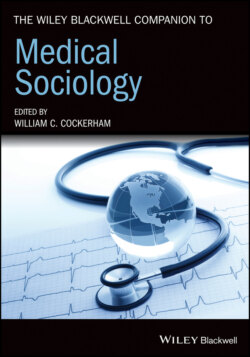Читать книгу The Wiley Blackwell Companion to Medical Sociology - Группа авторов - Страница 19
Sociology in Medicine
ОглавлениеSociology in Medicine is the subfield of medical sociology primarily focused on applied research within institutions of medicine, with substantive focus on medical treatment, health professions, and the marketing of health care (Broom et al. 2013; Cockerham 2017; Straus 1957). The sociologist in medicine is one who collaborates directly with physicians and other health personnel in studying the social factors that are relevant to addressing problems in health care settings. The work of the sociologist in medicine is intended to be directly applicable to patient care or to solving issues related to public health. In these ways, Sociology in Medicine can be characterized as applied research and analysis that is more motivated by medical problems than sociological problems. Sociologists in medicine usually work in medical schools, nursing schools, public health schools, teaching hospitals, public health agencies, and other health organizations. They may also work for a government agency, such as the US Department of Health and Human Services or the Centers for Disease Control and Prevention, in the capacity of biostatisticians, researchers, health intervention planners, and administrators.
Straus’s (1957) conception of Sociology in Medicine presented the emergent identity and hopes of a fledgling sociological sub-discipline. His survey of sociologists working on medical topics and in medical settings was one of several early publications (Anderson and Seacat 1957; Freeman and Reeder 1957; Mechanic 1966) that sought to claim a place and purpose for Sociology within Medicine’s rapidly changing and culturally powerful institutional environment. The distinction between sociologists studying medicine from the outside (Sociology of Medicine) and sociologists located inside medical settings and engaged in collaborative work with medical insiders (Sociology in Medicine) remains relevant today. For Straus (1957:203), these two approaches tended to be “incompatible with each other.” Correspondingly, Straus (1957) saw this tension as requiring those in the field to become “chameleons” in order to secure insider acceptance. Straus (1957: 203), argued that “there is a danger in this, for if the sociologist begins to talk like a physician, he [sic] may eventually come to act like a physician and even to think like a physician.”
Straus’ apprehensions were fundamentally about disciplinary identity and the dangers of over-identification with “the other” (i.e. physicians as an occupational group or medicine in general). More broadly, Straus and his contemporaries worried about the integrity of sociological objectivity along with the long-term independence of this new discipline. To read Straus and his peers (Bloom et al. 1960; Freeman et al. 1963) is to take a journey into the birth of a discipline at a time when neither acceptance nor a distinctive scholarly identity were foregone conclusions.
Now that medical sociology is a more established discipline, are Straus’s concerns still relevant? How can we best understand the contributions of sociologists who work in medical settings? What can we say about the training model of sociologists who desire to work in medical settings to address problems of importance to Medicine using a sociological lens?
We believe that sociologists in medicine bring a unique perspective to the table (Constantinou 2015). In what might reflect a form of cultural bias, Medicine tends to define many of its educational and clinical challenges at the level of individuals rather than as reflections of organizational or structural challenges. Examples abound. “Problems” with learning outcomes, as reflected in student test scores on exams such as the National Board of Medical Examiners Licensing examinations, are “solved” by recruiting ever-higher scoring applicants. The recent upsurge of interest within Medicine regarding “burnout” (Dyrbye et al. 2017) has been followed by efforts to provide employees with tools to ameliorate its effects rather than to invest time and resources to address the structural conditions that might give rise to emotionally toxic work environments. Meanwhile, the possibility that organizational units, such as medical schools, might themselves suffer from burnout is not even on the radar. Even Medicine’s recent attention to professionalism has remedially focused far more on teaching trainees and practitioners to be more professional, or to remediate “professionalism lapses” (a preferred term within medicine, but a sociologically evocative one) than on issues of contextual contributors, with concerns of “organizational professionalism” only recently gaining traction. Medicine still requires a sociological perspective to balance the prevailing lens of individualism.
Ospina and colleagues’ (2019) recent study of physician-patient communication is an excellent example of Sociology in Medicine. Using secondary data collected from a random sample of 112 clinical encounters, this study found that clinicians elicit the patient’s agenda in only 36% of encounters, with physicians interrupting the patient’s story 11 seconds into their meeting. Key concepts in this article include “shared-decision making,” “patient-centered care” and “patient-physician communication,” all of which can be linked to broader sociological concerns with the structure and dynamics of dyadic communication exchanges. Furthermore, studies on physician-patient communication remain a staple in the social science literature (Cortez et al. 2019; Oh 2017; Ong et al. 1995, 2000; Stepanikova et al. 2012).
